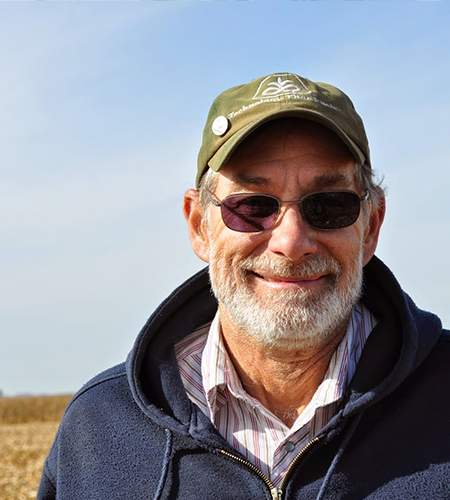I want to be known as a responsible farmer that isn’t afraid to find creative solutions. This takes a different way of thinking. I try to continually learn how to do things better.

Roger Zylstra
Jasper County

Farming Operation
- 2nd-generation family farm in Jasper County in central Iowa; son Wesley involved
- Corn and soybean rotation as well as continuous corn acres
- 75% of ground classified as highly erodible; remainder is less rolling
- Hog finishing units; manure integrated into nutrient plan
- Vice president of the Iowa Corn Promotion Board, involved with county Farm Bureau and a local marketing club
- Enrolled in the Soil Health Partnership
4R Plus Practices Used
- No-till on rotation ground
- Vertical-till on continuous corn acres
- Contours and grassed waterways on rolling ground; has a pond
- Cover crop is mixture of cereal rye and oats
- 75% of land injected with manure in the fall
- Starter fertilizer positions nutrients near the seed
- Variable-rate prescribed by testing
- Extensive history of soil testing from grid to manage nutrient timing, placement and rate
Results Seen
- Cover crops control erosion, build organic matter and protect water quality
- Cover crops capture nitrogen and control weeds to lower input costs
- Cover crops firm the ground for manure application process; help with water infiltration
- Vertical tillage breaks down cornstalks, reduces erosion and has boosted yields
- Applying only the nutrients needed saves on input costs and protects the water
Plans for the Future
- Fertilizer rate trials and trying different products to maximize efficiency of N, P and K
- Incorporate learnings from Soil Health Partnership to improve soil resiliency
- Keep precision farming technology up to date
- Investigate ways to manage nutrients for grain development
- Improve cover crop establishment in the fall to boost soil benefits
Click here to ask Roger a question about his farm.
Harvest 2019: Conservation Practices Provide Peace of Mind
After a challenging harvest in 2018, Jasper County, Iowa, farmer Roger Zylstra had high hopes the weather would be friendlier to his farm in 2019. Unfortunately, a high soil moisture profile this fall has him concerned about 2020. But a history of conservation practices that keep his soil protected gives him some peace of mind.
“The reality is we are not in control of the weather and need 4R Plus practices to protect our soil,” he said.
Zylstra was introduced to no-till in the ’60s and continues to fine-tune nutrient management and add conservation practices to protect the soil and the profitability of the farm.
Click here for the full story.
Summer 2019: Improving Soil Structure Allowed for Timely Planting
Jasper County farmer Roger Zylstra has learned the crop can’t make up for what’s lost on the front end of a growing season. After years of adding 4R Plus practices to improve soil structure, he’s more confident about pushing the front end of the planting window.
This spring he wrapped up planting on May 6. “Each year is unique, and another set of circumstances were thrown at us to show me I’m doing the right things. If you have good soil structure, you have a better chance of getting into and staying in the fields,” he said. “The 4R Plus practices I use, like no-till and cover crops, allowed me to push the front end of the planting window.”
Zylstra has been using no-till for more than 50 years on the ground he owns.
Click here for the full story.
Spring 2019: No-Till Improves Planting Conditions
Spring is an exercise in patience for farmers and it’s a virtue Jasper County Iowa farmer Roger Zylstra has practiced for many years. He’s glad he was introduced to no-till in the ’60s when his father led the operation, as it keeps him from being overly anxious about getting into the fields in the spring.
“Last fall was a reminder that no-till is the way to go if you want to keep the soil in place and improve its structure to support machinery,” he said in regard to the long, drawn-out harvest. “I’m thankful our fields don’t have big ruts to repair this spring.”
Zylstra says farmers in his area might be getting nervous because it was too wet in the fall for tillage and nitrogen applications. He recognizes that every farm operation is different, but he has had longtime success keeping yields trending higher in his no-till system.
Click here for the full story.
